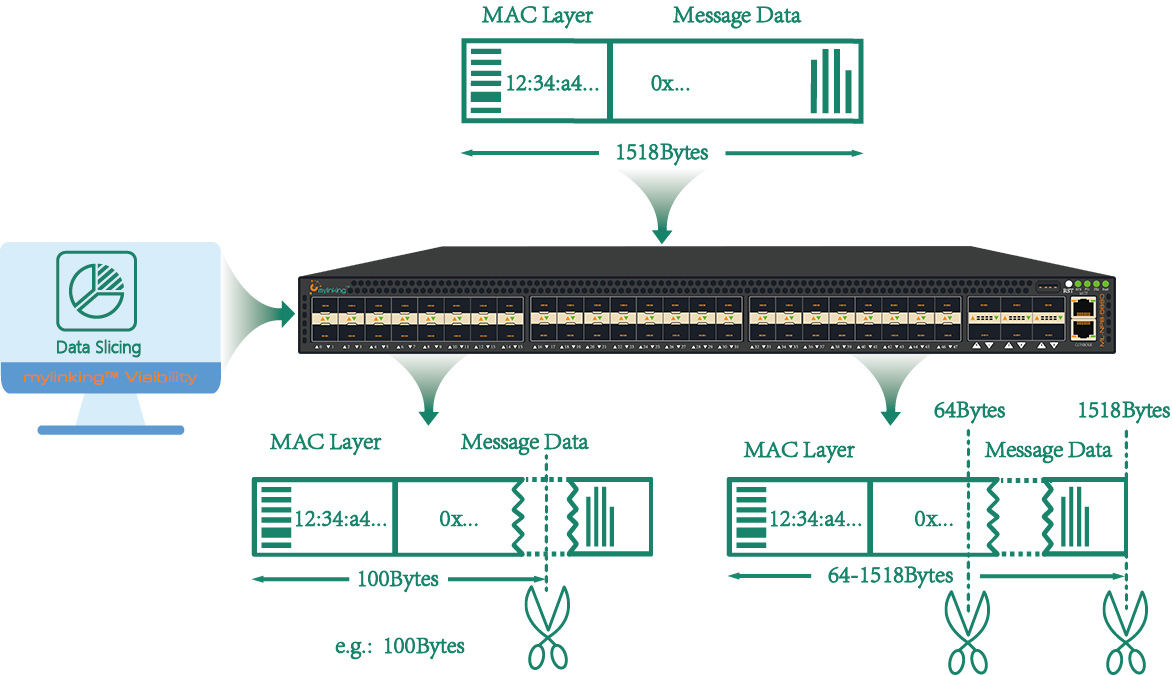What's the Packet Slicing of Network Packet Broker(NPB)?
Packet Slicing is a feature provided by network packet brokers (NPBs) that involves selectively capturing and forwarding only a portion of the original packet payload, discarding the remaining data. It allows for more efficient use of network and storage resources by focusing on the essential parts of network traffic. It is a valuable feature in network packet brokers, enabling more efficient and targeted data handling, optimizing network resources, and facilitating effective network monitoring and security operations.
Here's how Packet Slicing works on an NPB(Network Packet Broker):
1. Packet Capture: The NPB receives network traffic from various sources, such as switches, taps, or SPAN ports. It captures the packets passing through the network.
2. Packet Analysis: The NPB analyzes the captured packets to determine which parts are relevant for monitoring, analysis, or security purposes. This analysis can be based on criteria such as source or destination IP addresses, protocol types, port numbers, or specific payload content.
3. Slice Configuration: Based on the analysis, the NPB is configured to selectively retain or discard portions of the packet payload. The configuration specifies which sections of the packet should be sliced or retained, such as the headers, payload, or specific protocol fields.
4. Slicing Process: During the slicing process, the NPB modifies the captured packets according to the configuration. It can truncate or remove unnecessary payload data beyond a specific size or offset, strip certain protocol headers or fields, or retain only the essential parts of the packet payload.
5. Packet Forwarding: After the slicing process, the NPB forwards the modified packets to the designated destinations, such as monitoring tools, analysis platforms, or security appliances. These destinations receive the sliced packets, containing only the relevant portions as specified in the configuration.
6. Monitoring and Analysis: The monitoring or analysis tools connected to the NPB receive the sliced packets and perform their respective functions. Since the irrelevant data has been removed, the tools can focus on the essential information, enhancing their efficiency and reducing resource requirements.
By selectively retaining or discarding portions of the packet payload, packet slicing allows NPBs to optimize network resources, reduce bandwidth usage, and improve the performance of monitoring and analysis tools. It enables more efficient and targeted data handling, facilitating effective network monitoring and enhancing network security operations.
Then, why need the Packet Slicing of Network Packet Broker(NPB) for your Network Monitoring, Network Analytics and Network Security?
Packet Slicing in a Network Packet Broker (NPB) is beneficial for network monitoring and network security purposes due to the following reasons:
1. Reduced Network Traffic: Network traffic can be extremely high, and capturing and processing all packets in their entirety can overload monitoring and analysis tools. Packet slicing allows NPBs to selectively capture and forward only relevant portions of packets, reducing the overall network traffic volume. This ensures that monitoring and security tools receive the necessary information without overwhelming their resources.
2. Optimal Resource Utilization: By discarding unnecessary packet data, packet slicing optimizes the utilization of network and storage resources. It minimizes the bandwidth required for transmitting packets, reducing network congestion. Moreover, slicing reduces the processing and storage requirements of monitoring and security tools, improving their performance and scalability.
3. Efficient Data Analysis: Packet slicing helps focus on critical data within the packet payload, enabling more efficient analysis. By retaining only essential information, monitoring and security tools can process and analyze data more effectively, leading to faster detection and response to network anomalies, threats, or performance issues.
4. Improved Privacy and Compliance: In certain scenarios, packets may contain sensitive or personally identifiable information (PII) that should be protected for privacy and compliance reasons. Packet slicing allows for the removal or truncation of sensitive data, reducing the risk of unauthorized exposure. This ensures compliance with data protection regulations while still enabling necessary network monitoring and security operations.
5. Scalability and Flexibility: Packet slicing enables NPBs to handle large-scale networks and increasing traffic volumes more efficiently. By reducing the amount of data transmitted and processed, NPBs can scale their operations without overwhelming monitoring and security infrastructure. It provides flexibility to adapt to evolving network environments and accommodate growing bandwidth requirements.
Overall, packet slicing in NPBs enhances network monitoring and network security by optimizing resource usage, enabling efficient analysis, ensuring privacy and compliance, and facilitating scalability. It allows organizations to effectively monitor and protect their networks without compromising performance or overwhelming their monitoring and security infrastructure.
Post time: Jun-02-2023






